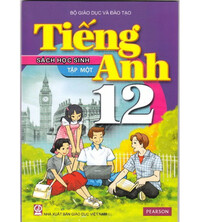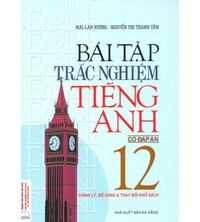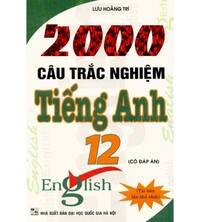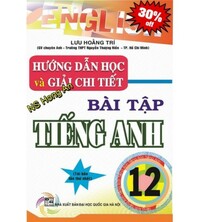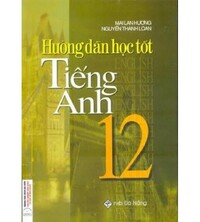Test yourself 1 - trang 40 SBT Tiếng anh 12 mới
Listen to the following sentences and underline the sounds that are affected by assimilation.
Bài 1
Task 1. Listen to the following sentences and underline the sounds that are affected by assimilation.
(Nghe những câu sau đây và gạch dưới những âm thanh mà bị ảnh hưởng bởi sự đồng hóa.)
1. The best man is standing next to the proud groom.
=> The best man is standing next to the proud groom.
Giải thích: t -> p, d -> g
2. We have already visited the Grand Canyon and the Golden Gate Bridge.
=> We have already visited the Grand Canyon and the Golden Gate Bridge.
Giải thích:d -> g, n -> ŋ, t -> p
3. She put the wet blanket into a white bag.
=> She put the wet blanket into a white bag.
Giải thích: t -> p
4. That old man placed the closed book on the desk and stood up.
=> That old man placed the closed book on the desk and stood up.
Giải thích: d -> b
5. My mother went to the open market to buy some chicken breasts.
=> My mother went to the open market to buy some chicken breasts.
Giải thích: n -> m
6. The rose show is organised in Great Britain every summer.
=> The rose show is organised in Great Britain every summer.
Giải thích: z -> ʒ , t -> p
7. In this university, equal numbers of both sexes enrolled in the earth science course.
=> In this university, equal numbers of both sexes enrolled in the earth science course.
Giải thích: θ -> s
8. They have turned many highland castles into first class hotels.
=> They have turned many highland castles into first class hotels.
Giải thích: d -> b, d -> g, t -> k
Bài 2
deplete employ conserve
agriculture efficiency
1. A lot of forests have been cut down to make way for_______ land.
=> A lot of forests have been cut down to make way for agricultural land.
Giải thích: agriculture (n): nông nghiệp => agricultural (adj): thuộc nông nghiệp, đứng trước danh từ cần điền một tính từ
Tạm dịch: Rất nhiều khu rừng đã bị đốn hạ để làm chỗ cho đất nông nghiệp
2. The world's fish populations are at risk of_______.
=> The world's fish populations are at risk of depletion.
Giải thích: đứng sau giới từ 'of' cần một danh từ, 'at risk of something': có nguy cơ gì
deplete (v): làm suy giảm, làm cạn kiệt => depletion (n): sự cạn kiệt, sự suy giảm
Tạm dịch: quần thể cá trên thế giới đang có nguy cơ cạn kiệt.
3. As the economy grew, the country's ______ rate dropped below 5% in February.
=> As the economy grew, the country's unemployment rate dropped below 5% in February.
Giải thích: 'unemployment rate' là một cụm: tỉ lệ thất nghiệp
employ (v): thuê làm, nhận vào làm => employment (n): sự thuê làm, việc làm >< unemployment (n): sự thất nghiệp, nạn thất nghiệp
Tạm dịch: Khi nền kinh tế tăng trưởng, tỷ lệ thất nghiệp của nước này đã giảm xuống dưới 5% vào tháng Hai.
4. The candidate decided to stop the campaign because it was too expensive and _______.
=> The candidate decided to stop the campaign because it was too expensive and inefficient.
Giải thích: Cấu trúc song song với 'and' nên cần điền một tính từ để cùng từ loại với 'expensive' (adj): đắt đỏ
efficiency (n): năng lực, hiệu suất => efficient (adj): hiệu quả, năng suất >< inefficient (adj): kém hiệu quả
Tạm dịch: ứng cử viên đã quyết định ngừng chiến dịch vì nó quá tốn kém và không hiệu quả
5. The first ______ areas were designated in 1967 in England.
=> The first conservation areas were designated in 1967 in England.
Giải thích: 'conservation area' là một cụm: khu bảo tồn
conserve (v): bảo tồn, bảo quản => conservation (n): sự bảo tồn
Tạm dịch: khu bảo tồn đầu tiên được thiết kế vào năm 1967 tại Anh.
Bài 3
Task 3. Choose the best answer to complete each sentence by circling A, B, C or D.
(Chọn câu trả lời đúng nhất để hoàn thành mỗi câu bằng cách khoanh tròn A, B, C hoặc D.)
1. It is recommended that people__________ regular exercise.
A. took B. to take
C. take D. taking
=> C
Giải thích: xuất hiện động từ 'recommend' => thức giả định: động từ của chủ ngữ thứ hai ở dạng nguyên thể
Tạm dịch: Mọi người nên tập thể dục thường xuyên
2. In the past, families were bigger because people__________ more children.
A. were having B. had
C. have D. have had
=> B
Giải thích: dấu hiệu 'in the past': trong quá khứ, cả hai mệnh đề nhân-quả đều đã xảy ra và kết thúc trong quá khứ nên chia QKĐ
Tạm dịch: Trong quá khứ, các gia đình lớn hơn vì mọi người có nhiều con hơn.
3. The police have advised people that their doors__________ locked at all times.
A. be kept B. kept
C. to be kept D. being kept
=> A
Giải thích: xuất hiện động từ khuyên bảo 'advise that...' => thức giả định nên động từ của chủ ngữ thứ hai ở dạng nguyên thể và dựa vào nghĩa của câu xác định đây là dạng bị động: be + Vp2
Tạm dịch: Cảnh sát khuyên mọi người rằng cửa nhà nên được khóa mọi lúc.
4. When I______ reading The Quiet American, I wanted to read other novels by Graham Greene.
A. was finishing B. used to finish
C. finish D. finished
=> D
Giải thích: Đây là câu kể lại những hành động liên tiếp xảy ra trong quá khứ => chia QKĐ
Tạm dịch: Khi tôi kết thúc việc đọc The Quiet American, tôi đã muốn đọc cuốn tiểu thuyết khác của Graham Greene.
5. _____ water is considered______ vital source of life, but______ water of Colox City is so polluted that people could die if they only drank______ drop of it.
A. x/a/the/a B. The/the/the/a
C. the/the/the/the D. x/x/x/x
=> A
Giải thích:
- Với danh từ không đếm được, dùng 'the' nếu nói đến một vật cụ thể, không dùng “the” nếu nói chung, 'water' trong câu này là sự vật chung chung
- 'source' là danh từ đếm được số ít và chưa xác định nên điền 'a' phía trước
- từ 'water' thứ hai là danh từ xác định 'of Colox City': Nước của thành phố Colox nên điền 'the' phía trước
- 'drop' là danh từ đếm được số ít và chưa xác định nên điền 'a' phía trước
Tạm dịch: Nước được coi là nguồn sống thiết yếu, nhưng nước của thành phố Colox ô nhiễm đến nỗi mọi người có thể chết nếu họ chỉ uống một giọt thôi.
6. More than ten students have failed the exams, which_______ the class teacher.
A. had surprised B. have surprising
C. is surprising D. has surprised
=> D
Giải thích: Hành động này bắt đầu từ quá khứ và vẫn tiếp diễn đến hiện tại, có khả năng kéo dài đến tương lai
Tạm dịch: Hơn 10 học sinh đã trượt kì thi, việc làm giáo viên lớp ngạc nhiên.
7. How much do you charge _______ a bunch of red roses?
A. to B. in
C. for D. with
=> C
Giải thích: to charge for something: tính giá, lấy bao nhiêu tiền cho cái gì
Tạm dịch: Bạn tính bó hồng này bao nhiêu tiền?
8. Before the Treaty of Versailles in 1919, many Germans _______ that the German army______ .
A. had not believed/was defeated
B. did not believe/had been defeated
C. were not believing have been defeated
D. have not believed/had been defeated
=> B
Giải thích:
- Diễn tả một sự kiện lịch sử trong một thời điểm trong quá khứ 'Before the Treaty of Versailles in 1919' nên động từ 'believe' chia QKĐ
- Động từ thứ hai nằm trong câu gián tiếp nên phải lùi thì QKĐ -> QKHT và dựa vào nghĩa xác định đây là dạng bị động be + Vp2
Tạm dịch: Trước Hiệp ước Versailles năm 1919, nhiều người Đức không tin rằng quân đội Đức đã bị đánh bại.
9. He _______ about his noisy neighbours five times today.
A. has been complaining B. has complained
C. would complain D. used to complain
=> B
Giải thích: dấu hiệu nhận biết 'five times' nhấn mạnh đến số lần thực hiện hành động => chia HTHT
Tạm dịch: Anh ấy đã phàn nàn về người hàng xóm ồn ào 5 lần ngày hôm nay.
10. As the plane was climbing________________ into the sky, the ground was getting________ away.
A. higher/far and far
B. higher/a little further
C. higher and higher/further and further
D. highest and highest/furthest and furthest
=> C
Giải thích: so sánh kép: comparative and comparative thể hiện sự tiến triển, phát triển của sự việc
Tạm dịch: Khi máy bay ngày càng cất cánh cao hơn lên bầu trời, mặt đất càng xa hơn.
11. I am exhausted. I _______ around the whole afternoon trying to clean the house before the guests arrive.
A. have been running B. have run
C. be running D. was running
=> A
Giải thích: nhấn mạnh hành động vẫn chưa kết thúc cho đến thời điểm hiện tại và vẫn tiếp diễn trong tương lai => chia HTHTTD
Tạm dịch: Tôi đang kiệt sức. Tôi đã chạy quanh cả buổi chiều cố gắng lau dọn sạch ngôi nhà trước khi khách đến.
12. I _______ Mary since this morning. Do you have any idea where she is?
A. have been phoned B. am phoning
C. have phoned D. have been phoning
=> D
Giải thích: diễn tả một hành động đã tiếp diễn ra bao lâu cho tới thời điểm hiện tại
Tạm dịch: Tôi đã gọi cho Mary từ sáng nay. Bạn có biết cô ấy ở đâu không?
13. He is not______ and finds it difficult to pay for daily necessities.
A. well-paid B. well-paying
C. well-prepared D. best paid
=> A
Giải thích: sau động từ 'to be' cần một tính từ và dựa vào nghĩa của câu xác định là dạng bị động Vp2
be well-paid: được trả lương cao
Tạm dịch: Anh không được trả lương cao và cảm thấy khó khăn để chi trả cho những thiết yếu hàng ngày.
14. There have been_______ efforts to reduce the impact of global warming on the planet.
A. world wide B. worldwide
C. planetwide D. wideworld
=> B
Giải thích: worldwide (adv)(adj): khắp thế giới
Tạm dịch: Có một nỗ lực toàn cầu để giảm thiểu tác động của việc trái đất nóng lên.
15 When I lived in London, I often visited___________ British Museum and_______________ Tower Bridge.
A. x/x B. the/the
C. the/x D. x/the
=> C
Giải thích: 'the' đứng trước danh từ đã xác định (mọi người đều biết đến)
Tạm dịch: Khi tôi sống ở London, tôi thường đến thăm Bảo tàng Anh và Tower Bridge
Bài 4+5
Task 4. Read the text and complete the sentences with the best answers by circling A, B, C or D.
(Đọc văn bản và hoàn thành các câu với câu trả lời đúng nhất bằng cách khoanh tròn A, B, C hoặc D.)
Lee Kuan Yew - the founding father of modern Singapore
Lee Kuan Yew was appointed as the first prime minister of Singapore in 1959 when the nation became a self-governing state. At that time, Singapore per capita income was only about USD400. When Lee stepped down in 1990, the figure was USD11,000 and in 2014 it went up to over 56,000, even higher than that of its former colonizer, Great Britain. In his memoirs published in 2000, he wrote 'They laughed at us, but I was confident that we would have the last laugh.'
Born into a middle-class Chinese family in Singapore, Lee was influenced by the language and institutions of the British rulers. He was destined to go to the UK to study law, but the Second World War broke out and he had to go to the local Raffles 10 College where he learnt some economics. It was not until 1946 when he talked his way to Cambridge and graduated three years later with a starred first. It was during this time that he nurtured ambitions beyond starting a legal career back home.
As a prime minister, he has always been described as an efficient and inventive person. He was one of the greatest statesmen who proved to the whole world that 15 human ingenuity, not natural resources, is the essential element of prosperity. Lee is also believed to be very forward-looking. When Singapore gained independence in 1965, he decided to keep English as the main language to increase economic benefits. Although many of his policies are still considered controversial, they helped Singapore to overcome many obstacles and become one of the most admired international business and financial centres around the world.
1. Lee Kuan Yew was Singapore's prime minister for______.
A. 31 years B. 55 years
C. 41 years D. 61 years
=> A
Giải thích: dẫn chứng nằm trong câu 1 và câu 3 đoạn 1 'Lee Kuan Yew was appointed as the first prime minister of Singapore in 1959' ( Lee Kuan Yew được tín nhiệm làm thủ tướng đầu tiên của Singapore năm 1959) và 'When Lee stepped down in 1990' ( Khi ông xuống chức vào năm 1990) => 31 năm
Tạm dịch: Lee Kuan Yew là thủ tướng của Singapore trong 31 năm.
2. The word 'destined' in line 8 is closest in meaning to _________
A. ordered B. scheduled
C. refused D. made
=> B
Giải thích:
destine (v): dự định
schedule (v): sắp xếp
order (v): ra lệnh, sắp đặt
refuse (v): từ chối
make (v): làm cho
Đoán nghĩa của từ dựa vào ngữ cảnh.
Ông đã được ........... để đến Vương quốc Anh để học luật, nhưng Chiến tranh thế giới thứ hai đã nổ ra và ông phải đến trường Raffles 10 ở địa phương nơi ông học kinh tế.
Tạm dịch: Từ 'destined' ở dòng 8 gần nghĩa nhất với ________
3. He did not go to Cambridge to study law until 1946 because ______
A. he had already been influenced by the British system
B. he had to study economics at Raffles College
C. Britain was at war
D. he did not want to pursue a legal career
=> C
Giải thích: dẫn chứng trong câu 2 đoạn 2 'He was destined to go to the UK to study law, but the Second World War broke out and he had to go to the local Raffles 10 College where he learnt some economics.' ( Ông đã được định để đến Vương quốc Anh để học luật, nhưng Chiến tranh thế giới thứ hai đã nổ ra và ông phải đến trường Raffles 10 ở địa phương nơi ông học kinh tế.'
Tạm dịch: Ông không đến Cambridge để học luật cho đến 1946 vì___________
A. ông đã bị ảnh hưởng bởi hệ thống của Anh
B. ông phải học kinh tế ở trường Raffles
C. nước Anh đang trong chiến tranh
D. ông không muốn theo đuổi sự nghiệp liên quan đến luật pháp
4. The word 'forward-looking' in line 16 is closest in meaning to
A. progressive
B. conservative
C. developing
D. distinguished
=> A
Giải thích:
forward-looking (adj): tiến lên, tiến bộ
progressive (adj): tiến lên, tăng dần
conservative (adj): bảo thủ
developing (adj): đang phát triển
distinguished (adj): xuất sắc, lỗi lạc
Dựa vào ngữ cảnh đoán nghĩa của từ, tạm dịch:
Lee cũng được cho là rất _____________. Khi Singapore giành được độc lập vào năm 1965, ông đã quyết định giữ tiếng Anh là ngôn ngữ chính để tăng lợi ích kinh tế.
5. According to the writer, Lee Kuan Yew's policies_________ .
A. were never subject to disagreement
B. promoted people's solidarity
C. transformed Singapore into a prosperous city
D. related to business and finance
=> C
Tạm dịch: Theo tác giả, các chính sách của Lee Kuan Yew__________
A. không bao giờ có khả năng bị bất đồng
B. tăng cường đoàn kết nhân dân
C. biến Singapore thành một thành phố thịnh vượng
D. liên quan đến kinh doanh và tài chính
Giải thích: dẫn chứng trong câu cuối ' Although many of his policies are still considered controversial, they helped Singapore to overcome many obstacles and become one of the most admired international business and financial centres around the world.'
Tạm dịch:
Mặc dù nhiều chính sách của ông vẫn bị coi là gây tranh cãi, nhưng chúng đã giúp Singapore vượt qua nhiều trở ngại và trở thành một trong những trung tâm kinh doanh và tài chính quốc tế được ngưỡng mộ nhất trên thế giới.
Task 5. Complete the text with the correct form of the words in the box. (Hoàn thành văn bản với hình thức đúng của các từ trong hộp.)
|
custom celebrate locate globe history |
The Times Square countdown is a popular New Year (1)________ in New York. On New Year's Eve, people come together in Times Square, the most famous tourist attraction in the world, to bring in the New Year. This is a very special time as spectators from all ethnic groups in the multicultural city of New York unite as a community. At 11.59 p.m. the ball (2) _____ on the roof of One Times Square starts to descend. It is a (3)________ for people to count down to zero, which is also the moment when the ball rests, and shout out ‘Happy New Year’.
This event has a long (4)_______ as the ball has been lowered every year since 1907. The Times Square Ball Drop has established itself not just as an annual celebration, but has become a (5) ________ tradition.
Đáp án:
The Times Square countdown is a popular New Year (1) celebration in New York. On New Year's Eve, people come together in Times Square, the most famous tourist attraction in the world, to bring in the New Year. This is a very special time as spectators from all ethnic groups in the multicultural city of New York unite as a community. At 11.59 p.m. the ball (2) located on the roof of One Times Square starts to descend. It is a (3) custom for people to count down to zero, which is also the moment when the ball rests, and shout out ‘Happy New Year’.
This event has a long (4) history as the ball has been lowered every year since 1907. The Times Square Ball Drop has established itself not just as an annual celebration, but has become a (5) global tradition.
Giải thích:
1. Đứng sau 'a' và tính từ 'popular' cần một danh từ
celebrate (v): tổ chức => celebration (n): lễ kỉ niệm
2. locate (v): đặt ở vị trí nào đó
Trong câu động từ được để ở dạng bị động, mệnh đề quan hệ ' the ball which is located' (quả bóng mà được đặt) đã được rút gọn
3. custom (n): phong tục, thói quen
Đứng sau 'a' cần một danh từ đếm được số ít
4. history (n): lịch sử
Đứng sau 'a' và một tính từ cần một danh từ đếm được số ít
5. globe (n): quả địa cầu => global (adj): toàn cầu
Đứng trước danh từ cần điền một tính từ
Tạm dịch:
Đếm ngược ở Quảng trường Thời đại là một lễ đón năm mới phổ biến ở New York. Vào đêm giao thừa, mọi người đến với nhau tại Quảng trường Thời đại, điểm thu hút khách du lịch nổi tiếng nhất thế giới, để đón năm mới. Đây là một thời gian rất đặc biệt vì khán giả từ tất cả các nhóm dân tộc ở thành phố đa văn hóa của New York đoàn kết như một cộng đồng. Vào lúc 11,59 phút, quả cầu nằm trên nóc Quảng trường Thời đại bắt đầu hạ xuống. Đó là một phong tục mà mọi người đếm ngược về không, cũng là khoảnh khắc quả cầu ngừng lại, và mọi người hét lên 'Chúc mừng năm mới'. Sự kiện này có một lịch sử lâu dài vì quả cầu đã được hạ xuống hàng năm kể từ năm 1907. Lễ thả cầu ở Quảng trườngThời đại đã thành lập không chỉ như một lễ kỷ niệm hàng năm, mà đã trở thành một truyền thống toàn cầu.
Bài 6+7
Task 6. Listen to a talk about the disadvantages of green living and choose the correct answer A, B, C or D. (Lắng nghe cuộc nói chuyện về những nhược điểm của cuộc sống xanh và chọn câu trả lời đúng A, B, C hoặc D.)
1. What is the most important drawback of green living?
A. Time.
B. Cost.
C. Limitation of options.
D. Environmental impacts.
=> B
Tạm dịch: Bất lợi quan trọng nhất của đời sống xanh là gì?
A. Thời gian
B. Tốn kém
C. Giới hạn những lựa chọn
D. Những ảnh hưởng môi trường
Giải thích: 'there are also some disadvantages including: time, limited options and, most importantly, cost.'
2. Which of the following does the writer NOT think is a reason for green living to be time-consuming?
A. Most people are not professional farmers.
B. Organic food takes longer to produce.
C. Green products are costly so it takes time to pay off the investment.
D. People have low budgets for producing their own food.
=> D
Tạm dịch:
Điều nào sau đây mà người viết KHÔNG nghĩ là một lý do khiến cuộc sống xanh trở nên tốn thời gian?
A. Hầu hết mọi người không phải là nông dân chuyên nghiệp.
B. Thực phẩm hữu cơ mất nhiều thời gian để sản xuất.
C. Sản phẩm xanh rất tốn kém nên cần có thời gian để trả hết khoản đầu tư.
D. Mọi người có ngân sách thấp để sản xuất thực phẩm của riêng họ.
Giải thích: dẫn chứng
A. 'they still have to face the fact that growing their own food takes time as they are not professional farmers'
B. 'if you want to grow an organic cabbage, you will have to spend on average one month more than the three months'
C. ' the investors need to wait longer to get their investment back'
D. không đề cập
3. How long does it take for an organic cabbage to grow?
A. One month.
B. Two months.
C. Three months.
D. Four months.
=> D
Tạm dịch:
Mất bao lâu để một bắp cải hữu cơ phát triển? A. Một tháng. B. Hai tháng. C. Ba tháng. D. Bốn tháng
Giải thích: 'if you want to grow an organic cabbage, you will have to spend on average one month more than the three months': nếu bạn muốn trồng một cây bắp cải hữu cơ, bạn sẽ phải dành trung bình nhiều hơn 3 tháng 1 tháng => 4 tháng
4. What are the three limitations in options mentioned in the talk?
A. Colours, materials, and fabrics
B. Colours, price range, and resources
C. Materials, markets, and fabrics
D. Markets, manufacturers, and price range
=> A
Tạm dịch:
Ba hạn chế trong các lựa chọn được đề cập trong bài nói chuyện là gì?
A. Màu sắc, chất liệu và cơ cấu
B. Màu sắc, phạm vi giá và tài nguyên
C. Vật liệu, thị trường và cơ cấu
D. Thị trường, nhà sản xuất và phạm vi giá
Giải thích: 'There are limitations in colours, materials, and fabrics.'
5. Why does the lecturer think that people should still adopt green lifestyles despite the disadvantages?
A. Because there is no other choice.
B. Because there are considerable financial benefits.
C. Because people's health and the environment will benefit.
D. Because the drawbacks are not considerable.
=> C
Tạm dịch:
Tại sao người nói nghĩ rằng mọi người vẫn nên áp dụng lối sống xanh bất chấp những bất lợi?
A. Vì không có lựa chọn nào khác.
B. Vì có lợi ích tài chính đáng kể.
C. Vì sức khỏe của mọi người và môi trường sẽ có lợi.
D. Vì những hạn chế không đáng kể
Giải thích: 'the benefits to people's health and the environment will be much more considerable': Lợi ích cho sức khỏe và môi trường sẽ đáng kể hơn nhiều
Audio script:
Good morning, everybody!
Today, I'll continue my talk about green lifestyles. While green living has surely brought numerous benefits to both people and the environment, there are also some disadvantages including: time, limited options and, most importantly, cost.
While many practices related to going green are designed to save money, green living can be quite expensive. For example, energy efficient appliances are designed to use less electricity, but they often come with a high price tag. Secondly, time can also be a big problem. Nowadays, more and more people are trying to adopt budget-friendly ways to have a green lifestyle. However, they still have to face the fact that growing their own food takes time as they are not professional farmers. For instance, if you want to grow an organic cabbage, you will have to spend on average one month more than the three months' time spent on a conventional cabbage. For those reasons, green products are usually more expensive and the investors need to wait longer to get their investment back.
The limitation of options can also be an obstacle. Although today there are more opportunities for manufacturers to go green and compete in a free market, for example, there are still not enough green alternatives for this. There are limitations in colours, materials, and fabrics.
However, I strongly believe that there is no reason why we should not join the green movement. Though there are some limitations, the benefits to people's health and the environment will be much more considerable.
Tạm dịch:
Chào buổi sáng mọi người!
Hôm nay, tôi sẽ tiếp tục bài nói chuyện về lối sống xanh. Mặc dù cuộc sống xanh chắc chắn đã mang lại nhiều lợi ích cho cả con người và môi trường, nhưng cũng có một số nhược điểm bao gồm: thời gian, lựa chọn bị hạn chế và quan trọng nhất là chi phí.
Trong khi rất nhiều cuộc thực hành liên quan đến việc sống xanh được thiết kế để tiết kiệm tiền, thì cuộc sống xanh có thể khá tốn kém. Ví dụ, các thiết bị tiết kiệm năng lượng được thiết kế để sử dụng ít điện hơn, nhưng chúng thường đi kèm với giá cao. Thứ hai, thời gian cũng có thể là một vấn đề lớn. Ngày nay, ngày càng có nhiều người cố gắng áp dụng những cách tiết kiệm để có lối sống xanh. Tuy nhiên, họ vẫn phải đối mặt với thực tế là tự trồng thực phẩm cần có thời gian vì họ không phải là nông dân chuyên nghiệp. Chẳng hạn, nếu bạn muốn trồng bắp cải hữu cơ, bạn sẽ phải dành trung bình nhiều hơn một tháng so với thời gian ba tháng dành cho bắp cải thông thường. Vì những lý do đó, các sản phẩm xanh thường đắt hơn và các nhà đầu tư cần phải chờ đợi lâu hơn để lấy lại tiền đầu tư.
Giới hạn của các lựa chọn cũng có thể là một trở ngại. Mặc dù ngày nay có nhiều cơ hội hơn cho các nhà sản xuất để sống xanh và cạnh tranh trong một thị trường tự do, ví dụ, vẫn không có đủ các lựa chọn thay thế xanh cho việc này. Có những hạn chế về màu sắc, vật liệu và vải.
Tuy nhiên, tôi tin tưởng mạnh mẽ rằng không có lý do gì chúng ta không nên tham gia phong trào xanh. Mặc dù có một số hạn chế, lợi ích đối với sức khỏe và môi trường của mọi người sẽ đáng kể hơn nhiều.
Task 7. The chart shows the number of Internet and mobile device users from 2005 to 2014. Study the chart and write a paragraph of 150-200 words describing it.
Biểu đồ cho thấy số lượng người sử dụng Internet và các thiết bị di động từ năm 2005 đến năm 2014. Nghiên cứu biểu đồ và viết một đoạn văn khoảng 150-200 từ miêu tả nó.
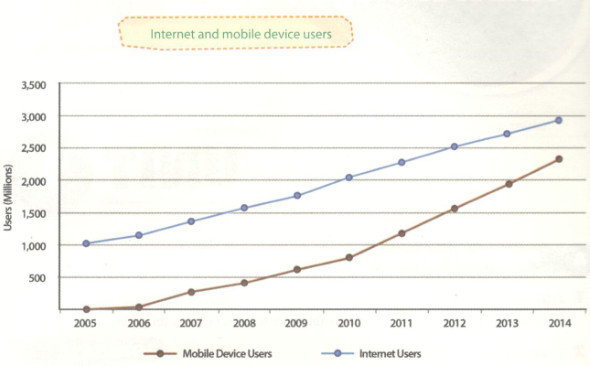
Gợi ý trả lời:
The line graph compares the number of Internet users with mobile device users during a period of nine years from 2005 to 2014.
As can be seen, the number of Internet users has been rising gradually from 2005. Starting from about 1,000 million users in 2005, the number of people using the Internet increased to just over 1,750 millions in 2009. Since then, the figure has risen at a faster and more stable pace, and as a result, the Internet now has some 2.9 billion users.
Similarly, the number of mobile device users has experienced a steep and constant upward trend for nine years. In the one-year period from 2005 to 2006, the figure remained at relatively the same level. However, over the next four years, the number of people who used mobile phones went up steadily from several millions to 800 millions in 2010. Since then, there has been a considerable growth in the number of users. The number of mobile device users today (in 2014) has reached 2.3 billion.
In conclusion, over the past nine years, both Internet and mobile device usage has increased. However, the substantial rise in the number of mobile device users shows that mobile devices are becoming more and more important.
Tạm dịch:
Biểu đồ đường so sánh số lượng người dùng Internet với người dùng thiết bị di động trong khoảng thời gian chín năm từ 2005 đến 2014.
Có thể thấy, số lượng người dùng Internet đã tăng dần kể từ năm 2005. Bắt đầu từ khoảng 1.000 triệu người dùng vào năm 2005, số người sử dụng Internet đã tăng lên chỉ hơn 1.750 triệu vào năm 2009. Kể từ đó, con số này đã tăng lên một tốc độ nhanh hơn và ổn định hơn, và kết quả là, Internet hiện có khoảng 2,9 tỷ người dùng.
Tương tự, số người dùng thiết bị di động đã trải qua một xu hướng tăng mạnh và liên tục trong chín năm. Trong giai đoạn một năm từ 2005 đến 2006, con số này vẫn duy trì ở cùng một mức một cách tương đối. Tuy nhiên, trong bốn năm tiếp theo, số người sử dụng điện thoại di động đã tăng đều đặn từ vài triệu lên 800 triệu trong năm 2010. Kể từ đó, số lượng người dùng đã tăng lên đáng kể. Số người dùng thiết bị di động hiện nay (năm 2014) đã đạt 2,3 tỷ.
Tóm lại, trong chín năm qua, cả việc sử dụng thiết bị di động và Internet đều tăng lên. Tuy nhiên, sự gia tăng đáng kể số lượng người dùng thiết bị di động cho thấy thiết bị di động ngày càng trở nên quan trọng.
Search google: "từ khóa + timdapan.com" Ví dụ: "Test yourself 1 - trang 40 SBT Tiếng anh 12 mới timdapan.com"
